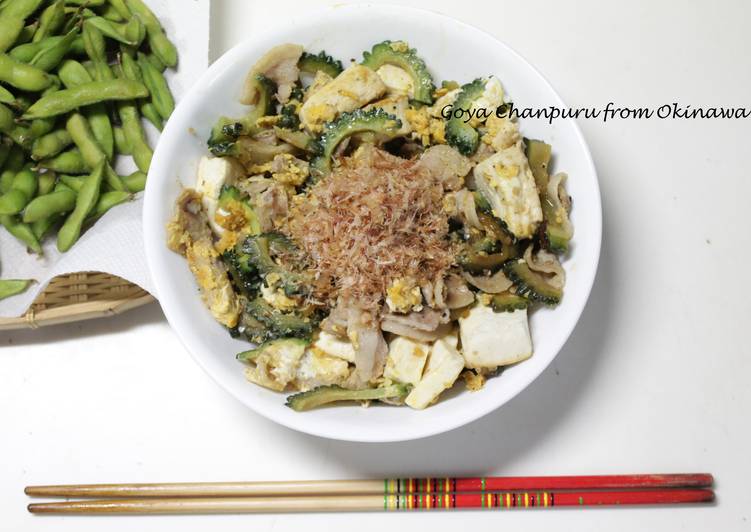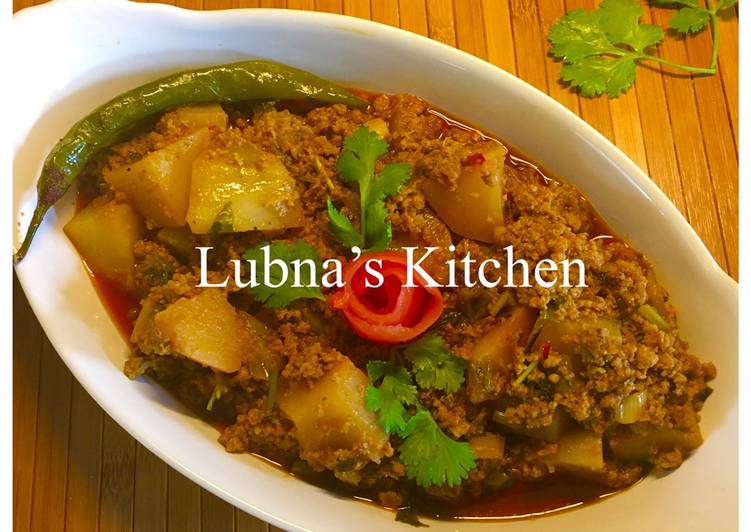
Hey everyone, I hope you’re having an incredible day today. Today, I’m gonna show you how to make a special dish, goya chanpuru, okinawan cuisine. One of my favorites food recipes. This time, I am going to make it a bit unique. This is gonna smell and look delicious.
Goya Chanpuru, Okinawan Cuisine is one of the most favored of recent trending meals on earth. It is simple, it’s fast, it tastes yummy. It is appreciated by millions daily. Goya Chanpuru, Okinawan Cuisine is something that I have loved my entire life. They are nice and they look wonderful.
Goya chanpuru (ゴーヤチャンプルー) is another representative Okinawan dish along with rafute and Okinawa soba. The word "chanpuru" sounds similar to the Indonesian word "campur" which means mix/stir and indeed, goya chanpuru is a bitter melon stir fry dish. "Goya" means bitter melon in Okinawa dialect. Okinawa's most iconic Goya Champuru is a stir fry dish with bitter melon, tofu, egg, and pork belly..
To get started with this recipe, we have to prepare a few ingredients. You can cook goya chanpuru, okinawan cuisine using 11 ingredients and 16 steps. Here is how you can achieve it.
The ingredients needed to make Goya Chanpuru, Okinawan Cuisine:
- Prepare 15 g sake (cooking alcohol or Japanese sake)
- Make ready 25 g soy sauce
- Prepare 1 Tablespoon Bonito stock (dashi)
- Prepare 1 pinch salt
- Take 15 g mirin
- Get 15 g sesame oil
- Make ready 1 Goya
- Make ready 150 g bacon
- Prepare 2 eggs
- Take 1 extra firm tofu
- Prepare Katuobushi, as needed
Chanpurū generally consists of tofu combined with some kind of vegetable, meat, or fish. Luncheon meat (such as Spam or Danish Tulip), egg, moyashi (bean sprouts) and gōyā (bitter melon) are some other common ingredients. Spam is not typically used in mainland Japan; but. Goya Chanpuru (Stir-Fried Bitter Melon) is a very popular Okinawan dish.
Instructions to make Goya Chanpuru, Okinawan Cuisine:
- First, prepare the sauce for goya chanpuru. Mix sake, soy sauce, mirin, salt,bonito stock all together.
- Hull the goya and cut it in the half lengthwise and take all seeds with a spoon or your fingers and discard them.
- Slice goya thin like the shape of letter C. Goya is a bitter melon. (If you do not like this bitterness, put the sliced goya in a water with salt and soak it for 10 minutes. I don't do this because I like this bitter taste)
- Wrap the extra firm tofu with 4 kitchen papers and microwave it for 1 minutes. This is for removing some of the water from the tofu so it makes a good crispy tofu.
- Prepare the bacon while microwaving the tofu. Cut the bacon in 5 cm length.
- Sprinkle salt and black paper on the sliced bacon
- Take the tofu out from the microwave and cut it into large cubes.
- Heat the large frying pan, add the olive oil, and cook the tofu till they brown.
- Remove the browned tofu from the pan.
- Put the sesame oil to the heated pan and add the bacon.
- Add the goya to the pan after the bacon is almost cooked. Mix well and continue stirring until the goya becomes wilted.
- Add the tofu and mix gently. Be careful not to scramble the tofu.
- Beat the eggs.
- Add the beaten egg and pour the sauce from step 1. When the egg is cooked, goya chanpuru is ready to be served!
- Add katsuobushi if you'd like! I always add one pack of katsuobushi to the goya chanpuru. This is available in an Asian market.
- Place the chanpuru on the plate and itadakimasu!
The dish is eaten very often in Summer in Japan when Goya (bitter melon/gourd/squash) is in season! Goya chanpuru is a cuisine of Okinawa, southern Japan and often eaten in summer season in Japan. Goya is a bitter melon with rich vitamin B and C. I somehow believe its bitterness helps me beat the heat in the summer. You can find goya in Asian or Latin market in the United States.
So that is going to wrap this up for this exceptional food goya chanpuru, okinawan cuisine recipe. Thank you very much for reading. I am confident you can make this at home. There’s gonna be more interesting food in home recipes coming up. Don’t forget to bookmark this page in your browser, and share it to your loved ones, friends and colleague. Thanks again for reading. Go on get cooking!


